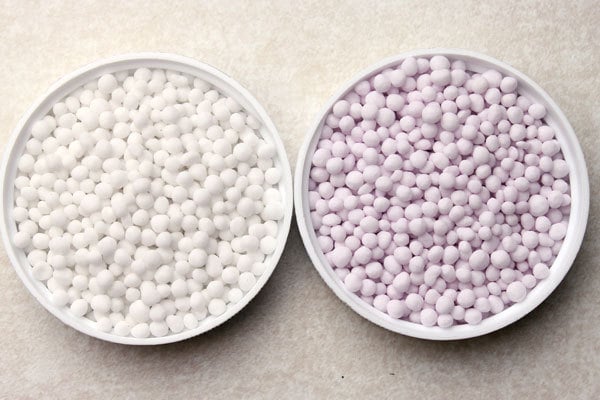As specialty fertilizer products become increasingly more commonplace, coating drums have emerged as a preferred way to incorporate beneficial additives and nutrients, reduce caking, and prevent dust in fertilizers, among other objectives.
More recently, coating drums have also become recognized as an effective way to coat fertilizers for improved nutrient use efficiency (NUE), in order to increase crop productivity, reduce environmental risks, and maximize investment.
The following covers the need for enhanced nutrient use efficiency, and how coating, particularly when carried out using a coating drum, can deliver just that.
The Need to Improve Nutrient Use Efficiency (NUE)
Nutrient use efficiency refers to how well a plant is able to utilize the nutrients provided to it. Unfortunately, studies have shown that nutrient use efficiency is typically very poor, with losses often being considerable:¹
- 40-70% Nitrogen losses
- 80-90% Phosphorus losses
- 50-70% Potassium losses
Losses can occur in the form of denitrification and volatilization (in the case of nitrogen), as well as leaching, runoff, and/or an inability of the plant to take up the nutrients.
Several factors are influencing the growing need to improve nutrient use efficiency in crop production:
Crop Productivity
Rapid urbanization and the ever-rising global population have put crop productivity in the spotlight as growers face the monumental task of growing more crops on fewer acres of arable land.
To meet future food security needs, we’ll have to maximize crop productivity, and this starts with crop nutrition; more and more, scientists are uncovering the critical tie between optimized nutrition and crop yield.
By providing balanced nutrition tailored to the soil and growing conditions, as well as the needs of the specific crop, growers have the best chance at achieving maximum crop yield.
ROI
Growers frequently face slim margins and high risks in cultivating their crops and bringing them to market. The ability to realize the full value of their investment in crop nutrition instead of watching much of it go to waste would not only improve the economics of crop production, but it would also alleviate the rising pressure growers face.
Environmental Risks
Inefficient nutrient utilization contributes losses to the environment, resulting in surface and groundwater contamination, harmful algal blooms, and greenhouse gas emissions.
As the effects of nutrient losses become more evident, the need to minimize the resulting detrimental environmental effects becomes more pressing.
By optimizing nutrient use efficiency, growers can minimize potential environmental risks by decreasing the potential for runoff and emissions to occur.
Wasted Phosphorus
In addition to all of this, the world has a limited supply of phosphate rock – currently the single most important (and an irreplaceable) source of phosphorus for crops.
Nutrient use efficiency is critical to maximizing available phosphate rock resources and preventing them from going to waste.
Achieving Nutrient Use Efficiency
The ability to optimize nutrient use efficiency would address each of the challenges discussed here, and give growers a critical toolset to face the evolving demands of modern agriculture and the anticipated higher use of fertilizers needed to meet future food security requirements.
Further, when nutrient use efficiency is increased, less fertilizer can be applied. This allows growers to spend less on their nutrient inputs, while also decreasing pressure on natural resources and the need to produce additional fertilizers. It also translates to fewer applications, lower labor costs, less energy use, and decreased time.
To reach nutrient use efficiency goals, many fertilizer producers are turning to coating.
How Coating Improves Nutrient Use Efficiency
Coating can be used as a way to improve nutrient use efficiency by controlling the release rate of nutrients.
While various coatings may function differently, in general, these controlled-release fertilizers, or CRFs, prevent the initial deluge of nutrients that can occur with some uncoated fertilizers, instead providing nutrients more gradually over time so the plant has more opportunity to take them in as needed. This results in higher nutrient use efficiency and a reduced potential for losses to occur.
Typically this slower breakdown occurs because the coating creates a barrier between the nutrient and its surrounding environment, preventing or reducing the permeation of moisture into the granule, so it breaks down more gradually.
Numerous coatings, both organic and inorganic, have been and continue to be explored. Each offers its own advantages and disadvantages, with common options including:
- Sulfur
- Wax
- Oils
- Polymers
- Other specialty coatings
Coatings may be applied to either single nutrient products or complex fertilizers.

Urea granules before (left) and after (right) coating testing in the FEECO Innovation Center
Coating Drums to Ensure Coating Performance
Developing a solid coating formulation is an essential step, but proper coating performance goes beyond formulation; coatings must be expertly applied in order to perform as designed or they provide little value.
Fertilizer producers have a few different options when it comes to coating equipment and should evaluate each option carefully based on their specific process and product goals.
Coating drums typically provide the best results, offering a high throughput, gentle handling, and a uniformly coated product.
About Fertilizer Coating Drums
Coating drums work by tumbling granules in a rotating bed, onto which the coating is sprayed at strategic points. The tumbling bed causes granule-to-granule contact, evenly distributing the coating onto each granule and throughout the bed. Agitation flights can be employed to increase bed turning and agitation.

3D Rendering of a FEECO Coating Drum
Coating Drum Tips for fertilizers
In addition to selecting a coating drum, producers can also ensure desired coating performance by:
Using A Granular Product
Coatings are typically applied to a granular or prilled product. This provides a good substrate onto which the coating can be applied and allows the fertilizer producer to more easily control the characteristics of the finished product during application of the coating.
In producing the granular product itself, manufacturers are also able to control particle characteristics that they can use to help optimize the coating application.
Testing the Coating Drum Process
Testing such as that carried out in the FEECO Innovation Center is a key step in developing a coating process that performs as designed; coating application must be precise for the coating to be effective, and numerous factors can influence the process.
In the case of a coating drum, the Innovation Center works with a host of variables to optimize the coating application and produce the desired results. This includes:
- Coating temperature
- Material temperature
- Coating application rate
- Material feed rate
- Spray method and location
- Nozzle type
- Drum fill percentage
- Retention time
- Drum speed

The temperature of the material bed is measured during a coating drum testing in the Innovation Center
The Innovation Center can accommodate testing at both batch and pilot scale to confirm feasibility (proof of concept), as well as show proof of product and proof of process. Once the optimal process parameters have been identified, the data gathered can be used to engineer a commercial-scale coating drum.
Conclusion
Fertilizer coating offers an effective way to improve nutrient use efficiency so that growers can realize the full value of their investment while reducing environmental risks, maximizing crop productivity, and protecting finite resources. Coating drums typically offer the best results, but testing is an important part of developing a successful coating line.
FEECO is a preferred provider of custom coating drums for the fertilizer industry, with extensive testing and development capabilities, as well as parts and service support available. For more information on our coating drums or testing capabilities, contact us today!

